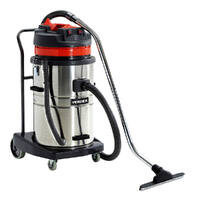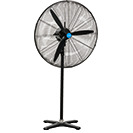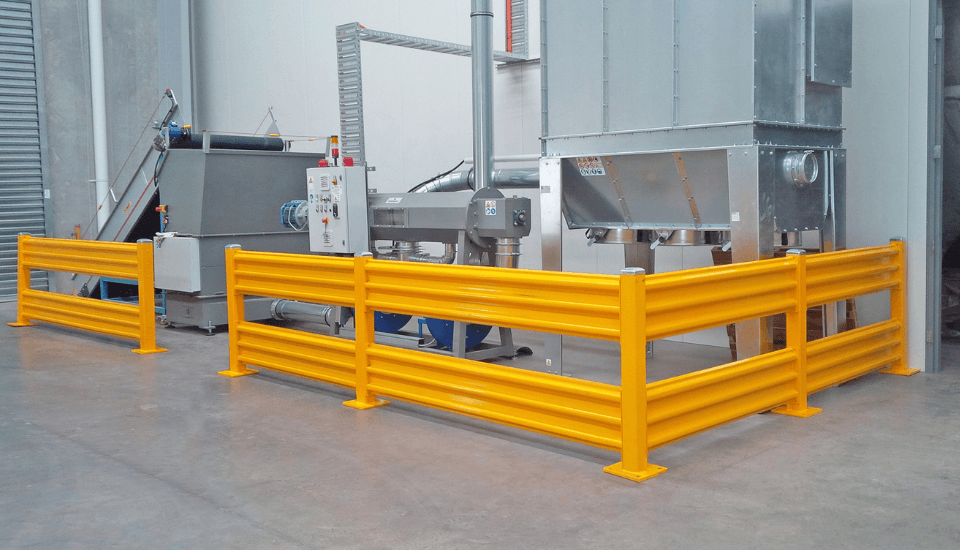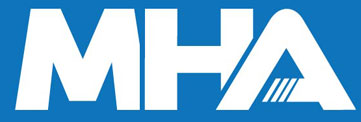Workplaces That Rely On Safety Barriers
Date Posted:21 July 2025
Not sure if your site needs safety barriers? Think again. Safety barriers help a range of Australian businesses stay compliant, boost productivity, and protect workers.
Verdex Insights: At a Glance
-
The Challenge: Many Australian workplaces face overlapping risks from vehicles, equipment, and foot traffic. Without proper barrier systems, even well-trained teams are vulnerable to collisions, property damage, or WHS breaches.
-
The Insight: Safety barriers create a structured, compliant separation between people, vehicles, and high-risk zones. From warehouses to mining operations, they prevent costly accidents, reduce downtime, and form the foundation of effective traffic management under WHS law.
-
The Verdex Solution: Verdex provides durable, high-visibility safety barriers designed for industrial, commercial, and construction sites. Our range includes guardrails, bollards, wheel stops, and modular barrier systems, all engineered for impact resistance, flexibility, and WHS compliance. Combined with PPE, first aid kits, and workplace safety signage, Verdex delivers complete safety solutions that help businesses protect people, assets, and productivity.
Why Do Certain Workplaces Depend on Safety Barriers?
In many Australian workplaces, hazards such as moving machinery, forklifts, human error, and environmental risks pose significant safety threats.
Safety barriers act as a frontline defence by creating physical separations between people and potential danger zones. They are essential in reducing incidents, protecting infrastructure, and maintaining smoother workflows across industrial, commercial, and construction environments.
More than just preventative, barriers also support compliance with Australia’s Work Health and Safety (WHS) regulations. Employers have a legal "Duty of Care" to manage workplace risks, which includes implementing effective traffic management systems.
Safety barriers are often a key element of these systems, helping facilities meet compliance standards while enhancing overall operational safety.
Key Industries That Rely on Safety Barriers
Warehousing and Logistics
Warehouses depend heavily on safety barriers to manage high levels of traffic between forklifts, pallet jacks, and personnel. Barriers help separate vehicles from pedestrian walkways, reducing collision risks.
Some of our preferred solutions for these work environments include a number of:
Racking protection systems are installed to safeguard shelving from impact damage. Temporary zones can be created using modular barriers to safely conduct picking, packing, or inventory tasks. These measures not only reduce accidents but also ensure efficient warehouse flow.
To further enhance safety and improve overall warehouse functionality, it’s important to complement these systems with the right workplace safety equipment supplies.
Manufacturing and Production Facilities
In fast-paced manufacturing environments, machine guards and modular fencing help shield employees from high-speed automation, robotics, and conveyor systems.
Physical separation reduces the chance of accidental contact, especially in automated or semi-automated production lines.
Safety barriers also help with zoning, allowing clear demarcation of work areas for tasks such as material loading, assembly, or quality checks.
Construction Sites
Construction areas are dynamic and inherently hazardous. Temporary pedestrian barriers and high-visibility bollards, such as large fixed safety bollards and t-top plastic bollards, help guide workers and visitors safely around danger zones.
These barriers comply with strict WHS codes relevant to construction and demolition activities. Modular systems are ideal for construction sites because they can be quickly deployed or reconfigured as the layout evolves.
Transport Depots and Loading Docks
Loading docks and transport depots are hot spots for accidents, especially during truck reversing and forklift operations. Forklift wheel stops and safety guardrail fencing around bays and entrances protect equipment, buildings and people.
Bollards provide impact resistance in high-traffic areas, and clearly marked pedestrian walkways offer a safer path for drivers and dock workers.
Food and Beverage Processing
In these hygiene-sensitive environments, stainless steel or food-grade safety barriers are used to segregate workers from hazardous equipment like slicers or fillers. These barriers are easy to clean and resistant to moisture or bacteria, supporting sanitary compliance. Modular designs make it easy to adapt to layout changes or regular washdowns.
Mining and Heavy Industry
Safety barriers in mining must withstand extreme impact and harsh conditions, including heat, dust, and moisture.
Heavy-duty bollards and reinforced guardrails are used to protect both people and machinery near crushers, explosive zones, or heavy equipment areas.
Car Parks
Even outside of industrial zones, car parks rely on bollards, wheel stops, and pedestrian barriers to organise vehicle movement and reduce risk to pedestrians. These systems improve visibility, reduce accidents, and guide traffic safely.
What Makes Safety Barriers So Valuable in These Settings?
Safety barriers are more than physical dividers—they’re strategic tools that help businesses operate more safely and efficiently. They reduce workplace downtime caused by accidents, infrastructure damage, or near-miss incidents. Barriers also help sites remain compliant with WHS and ISO safety standards, avoiding legal or financial penalties.
To support a comprehensive safety strategy, barriers are often used alongside other critical solutions such as first aid equipment, PPE clothing and safety gear, and clear workplace signage. They each play a vital role in protecting employees and maintaining a compliant, high-functioning site. When workers feel protected by well-integrated safety systems, confidence and morale increase, often leading to better productivity.
Long-term, investing in quality safety barriers can reduce costs associated with damaged equipment, medical expenses, and insurance claims. In environments where safety, compliance, and operational continuity are non-negotiable, safety barriers prove to be an invaluable asset.
Internal Safety Reviews: When to Reassess Your Barrier Systems
Workplace safety is not a set-and-forget responsibility. Regular reviews ensure your safety systems remain effective as your site evolves. Some steps to follow include:
-
Consider reassessing your barriers when your facility expands, new machinery is installed, or pedestrian and vehicle traffic patterns change.
-
After any incident report or near-miss event, a safety review can identify gaps that need immediate attention.
-
Annual WHS audits are also key triggers for checking barrier placement, visibility, and condition.
-
Other reasons to re-evaluate include shifts in regulatory requirements, the introduction of automated equipment, or changes in operating hours.
-
Periodic reviews help future-proof your workplace and ensure continued compliance.
How Verdex Supports Australian Workplaces with Barrier Systems
At Verdex, we specialise in high-quality safety barrier solutions tailored for Australian workplaces. Our extensive product range includes guardrails, heavy-duty bollards, pedestrian barriers, and modular fencing systems.
Whether you need fixed or flexible options, our products are made from durable materials designed to handle high-impact zones and meet WHS compliance. We also offer custom solutions and a range of materials handling equipment to match your site’s unique safety challenges.
With national delivery, expert support, and a trusted supplier network, Verdex makes it easy to upgrade your safety systems with confidence.
For more information, speak to our friendly team by:
-
Emailing us at sales@verdex.com.au
-
Or fill out our contact form
FAQs
How do I know if my worksite is compliant?
A WHS professional or safety auditor can assess your facility to ensure your traffic management systems and safety barriers meet national standards. Regular audits and safety reviews are highly recommended.
Are safety barriers only for industrial settings?
No. Safety barriers are used across commercial, retail, and public environments such as car parks, healthcare facilities, and schools, as well as traditional industrial zones.
Can safety barriers be moved or reconfigured?
Yes. Many modern barrier systems are modular, allowing you to reconfigure them as your layout or safety needs change. This is especially useful in growing or temporary workspaces.
Do different industries need different types of safety barriers?
Absolutely. Each industry faces unique hazards. For example, food processing needs hygienic barriers, while mining requires impact-resistant, weatherproof systems.
What colour should my safety barriers be?
In most cases, bright colours like yellow or orange are used to maximise visibility. Specific colour standards may apply depending on the barrier's function or industry guidelines.
































































































































 Trolleys & Hand Trucks
Trolleys & Hand Trucks Cage Trolleys
Cage Trolleys Cleaning Carts & Trolleys
Cleaning Carts & Trolleys Construction Trolleys
Construction Trolleys Custom Trolleys
Custom Trolleys Hand Trucks & Dollies
Hand Trucks & Dollies Laundry/Linen Trolleys
Laundry/Linen Trolleys Lifting Trolleys
Lifting Trolleys Order Picking Trolleys
Order Picking Trolleys Panel Cart Trolleys
Panel Cart Trolleys Platform Trolleys
Platform Trolleys Powered Trolleys
Powered Trolleys Shelf & Tiered Trolleys
Shelf & Tiered Trolleys Shopping Trolleys
Shopping Trolleys Stainless Steel Trolleys
Stainless Steel Trolleys Tool Trolleys
Tool Trolleys Utility & Service Carts
Utility & Service Carts Lifting & Handling Equipment
Lifting & Handling Equipment Forklift Attachments
Forklift Attachments Jib Attachments
Jib Attachments Lifting Hoists & Pallet Hooks
Lifting Hoists & Pallet Hooks Load Skates & Tow Tugs
Load Skates & Tow Tugs Manual Stackers & Lifters
Manual Stackers & Lifters Pallet Jacks
Pallet Jacks Pallet Lifters
Pallet Lifters Pallet Rotators & Dispenser
Pallet Rotators & Dispenser Powered Pallet Trucks & Electric Lifters
Powered Pallet Trucks & Electric Lifters Scissor Lift Trolleys and Tables
Scissor Lift Trolleys and Tables Conveyor Equipment
Conveyor Equipment Conveyor Frames & Stands
Conveyor Frames & Stands Roller & Skate Conveyors
Roller & Skate Conveyors Ladders & Access Equipment
Ladders & Access Equipment Container & Yard Ramps
Container & Yard Ramps Ladders & Step Stools
Ladders & Step Stools Work Platforms & Crane Cages
Work Platforms & Crane Cages Drum Handling Equipment
Drum Handling Equipment Drum Storage & Bunding
Drum Storage & Bunding Drum Trolleys & Lifters
Drum Trolleys & Lifters Forklift Drum Handling
Forklift Drum Handling Waste Handling & Bins
Waste Handling & Bins Bin Lifters & Tippers
Bin Lifters & Tippers Plastic Waste & Wheelie Bins
Plastic Waste & Wheelie Bins Steel Waste & Tipping Bins
Steel Waste & Tipping Bins Waste Carts
Waste Carts Dangerous Goods Storage & Spillage
Dangerous Goods Storage & Spillage Aerosol Cans Storage Cages
Aerosol Cans Storage Cages Bunded Pallets & Storage
Bunded Pallets & Storage Corrosive Goods Storage Cabinets
Corrosive Goods Storage Cabinets DG Storage & Trolleys
DG Storage & Trolleys Flammable Liquid Cabinets
Flammable Liquid Cabinets Forklift Gas Storage Cages
Forklift Gas Storage Cages Site Storage
Site Storage Spill Kits
Spill Kits Shelving & Storage Equipment
Shelving & Storage Equipment Stillage & Transport Cages
Stillage & Transport Cages 750 Series Cage Configurations
750 Series Cage Configurations Heavy Duty Cabinets
Heavy Duty Cabinets Heavy Duty Shelving
Heavy Duty Shelving Mega Bins & Pallets
Mega Bins & Pallets Packing & Workbenches
Packing & Workbenches Parts Trays & Stor-Pak Bins
Parts Trays & Stor-Pak Bins Pegboard & Louvre Panels
Pegboard & Louvre Panels Plastic Bins & Crates
Plastic Bins & Crates Plastic Handling Solutions Bins
Plastic Handling Solutions Bins Plastic Pallets
Plastic Pallets Stack & Nest Bins
Stack & Nest Bins Pallet Racking Accessories
Pallet Racking Accessories Workplace Equipment
Workplace Equipment Modular Workbenches
Modular Workbenches Electric Height-Adjustable Workbenches
Electric Height-Adjustable Workbenches Floor Matting
Floor Matting General Workplace Equipment
General Workplace Equipment Industrial Weighing Scales
Industrial Weighing Scales Packaging Machinery
Packaging Machinery Stationery Cupboards
Stationery Cupboards Storage and Stillage Cages
Storage and Stillage Cages Tool Trolleys
Tool Trolleys Tooling Cabinets
Tooling Cabinets Workshop Fans and Coolers
Workshop Fans and Coolers Safety Barriers, PPE & Signage
Safety Barriers, PPE & Signage Barriers & Bollards
Barriers & Bollards First Aid Equipment
First Aid Equipment Gloves, Knives and PPE
Gloves, Knives and PPE Signage
Signage Cleaning & Site Supplies
Cleaning & Site Supplies Cleaning Equipment
Cleaning Equipment Cleaning Trolleys
Cleaning Trolleys Rubbish Bins
Rubbish Bins Signs & Traffic Supplies
Signs & Traffic Supplies Construction Equipment
Construction Equipment Construction Trolleys
Construction Trolleys Waste Handling
Waste Handling General Site Equipment
General Site Equipment Concrete Equipment
Concrete Equipment Site Storage
Site Storage Lifting Equipment
Lifting Equipment Verdex Specials
Verdex Specials











